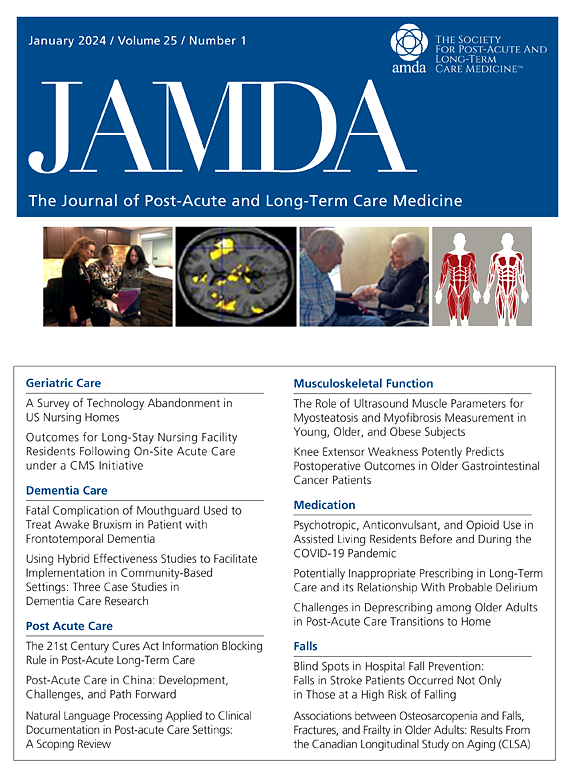多种药物对社区居住老年人自评健康的影响:一项为期3年的SONIC研究
IF 4.2
2区 医学
Q2 GERIATRICS & GERONTOLOGY
Journal of the American Medical Directors Association
Pub Date : 2025-05-22
DOI:10.1016/j.jamda.2025.105621
引用次数: 0
摘要
目的:以前的研究报道了多药(PP)与客观健康指标有关,如跌倒或身体功能下降。然而,很少有研究考察PP与主观健康指标(如自评健康(SRH))之间的关系。因此,本研究探讨了老年人PP和SRH之间的关系。设计:前瞻性研究。环境和参与者:本研究纳入了SONIC纵向队列研究的参与者。方法:在完成基线调查和3年随访调查的参与者中,有完整项目的1103人纳入分析。多重用药分为0、1-4、5-9 (PP)和≥10 (hyper-PP) 4类。根据学生的反应将学生的健康状况分为好(极好/好)和差(不太好/差)两组。在调整年龄、性别、经济状况、日常生活工具活动、抑郁情绪和慢性病数量后,采用多变量logistic回归分析评估基线PP与3年后SRH之间的前瞻性关系。结果:多变量logistic回归分析显示,PP(调整优势比[aOR], 3.159;95%置信区间[CI], 1.479-6.747)和hyper-PP (aOR, 5.000;95% CI, 1.884-13.27)与不良SRH显著相关。结论和意义:药物数量的增加与较差的SRH密切相关。患有PP的老年人需要定期观察和检查,不仅要检查所治疗的疾病,还要检查其健康的各个方面,包括性健康和生殖健康及其药物的不良影响。本文章由计算机程序翻译,如有差异,请以英文原文为准。
Impact of Polypharmacy on Self-Rated Health in Community-Dwelling Older Adults: A 3-Year SONIC Study
Objectives
Previous studies have reported that polypharmacy (PP) is associated with objective health indicators, such as falls or a decline in physical function. However, few studies have examined the relationship between PP and subjective health indicators, such as self-rated health (SRH). Therefore, this study examined the association between PP and SRH in older adults.
Design
Prospective study.
Setting and Participants
Participants from the longitudinal cohort study of the SONIC were included in this study.
Methods
Among the participants who completed the baseline and 3-year follow-up surveys, 1103 with complete items were included in the analysis. Multiple medication use was categorized into 4 categories: 0, 1–4, 5–9 (PP), and ≥10 (hyper-PP). SRH was categorized into 2 groups according to the responses: good (excellent/good) and poor (not good/poor). Multivariable logistic regression analysis was performed to assess the prospective relationship between PP at baseline and SRH 3 years later after adjusting for age, sex, economic status, instrumental activities of daily living, depressive mood, and the number of chronic conditions.
Results
The multivariable logistic regression analysis showed that PP [adjusted odds ratio (aOR), 3.159; 95% confidence interval (CI), 1.479–6.747] and hyper-PP (aOR, 5.000; 95% CI, 1.884–13.27) were significantly associated with poor SRH.
Conclusions and Implications
An increase in the number of medications was strongly associated with poor SRH. Older people with PP need to be regularly observed and reviewed not only for the disease being treated but also for various aspects of their health, including SRH and the adverse effects of their medication.
求助全文
通过发布文献求助,成功后即可免费获取论文全文。
去求助
来源期刊
CiteScore
11.10
自引率
6.60%
发文量
472
审稿时长
44 days
期刊介绍:
JAMDA, the official journal of AMDA - The Society for Post-Acute and Long-Term Care Medicine, is a leading peer-reviewed publication that offers practical information and research geared towards healthcare professionals in the post-acute and long-term care fields. It is also a valuable resource for policy-makers, organizational leaders, educators, and advocates.
The journal provides essential information for various healthcare professionals such as medical directors, attending physicians, nurses, consultant pharmacists, geriatric psychiatrists, nurse practitioners, physician assistants, physical and occupational therapists, social workers, and others involved in providing, overseeing, and promoting quality

 求助内容:
求助内容: 应助结果提醒方式:
应助结果提醒方式:


